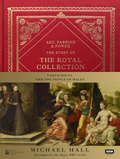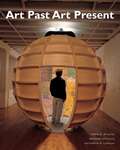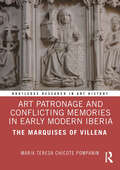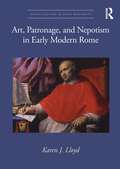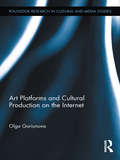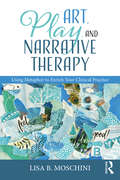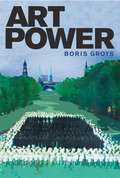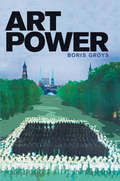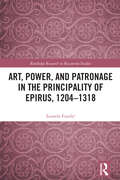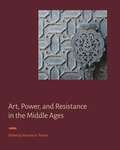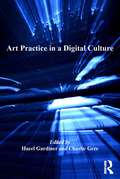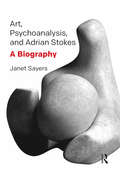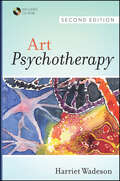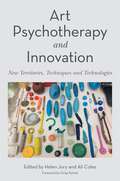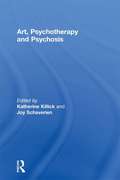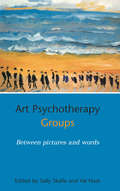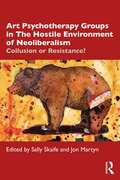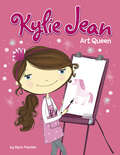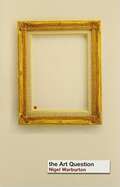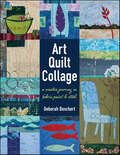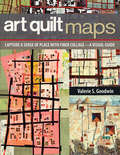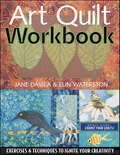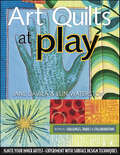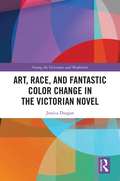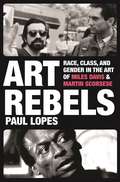- Table View
- List View
Art, Passion & Power: The Story of the Royal Collection
by Michael Hall"Hall’s consummate history is not just the story of the evolution of one of the world’s great collections… The book is also a through-the-keyhole insight into the shifting tastes, good or bad, of 1,000 years of monarchs."- The TimesThe Royal Collection is the last great collection formed by the European monarchies to have survived into the twenty-first century. Containing over a million artworks and objects, it covers all aspects of the fine and decorative arts, from paintings by Rembrandt and Michelangelo to grand sculpture, Fabergé eggs and some of the most exquisite furniture ever made. The Royal Collection also offers a revealing insight into the history of the British monarchy from William the Conqueror to Queen Elizabeth II, recording the tastes and obsessions of kings and queens over the past 500 years. With unprecedented access to the royal residences of St James' Palace, Windsor Castle and Buckingham Palace, Art, Passion & Power traces the history of this national institution from the Middle Ages to the present day, exploring how royalty used the arts to strengthen their position as rulers by divine right and celebrating treasures from the Crown Jewels to the "Abraham" tapestries in Hampton Court Palace. Author Michael Hall examines the monarchy's response to changing attitudes to the arts and sciences during the Enlightenment and celebrates the British monarchy's role in the democratisation of art in the modern world. Packed with glimpses of rarely seen artworks, Art, Passion & Power is a visual treat for all art enthusiasts. Accompanying the BBC television series and a major exhibition at the Royal Academy, Art, Passion & Power is the definitive statement on the British monarchy's treasures of the art world.
Art Past Art Present
by David G. Wilkins Bernard Schultz Katheryn M. LinduffAuthoritative and substantive-yet accessible-Art Past, Art Present, 6th edition looks at the historical and cultural contexts of art works and architecture around the world from prehistoric times to the 20th century. The authors recognized the need for an easy-to-use format that is accessible for both teachers and students. Each topic in Art Past, Art Present is organized into two- and four-page units and provides a clear and concise treatment of a select number of artworks, making it easier for instructors to focus on what is important and for students to learn.
Art Patronage and Conflicting Memories in Early Modern Iberia: The Marquises of Villena (Routledge Research in Art History)
by Maria Teresa Chicote PompaninThis volume investigates the mechanisms (artworks, treatises, and other forms of cultural patronage) that the Marquises of Villena and their opponents used to operate in the cultural battlefield of the time with the aim of understanding how their conflicting historical memories were constructed and manipulated. Concentrating on the late fifteenth and early sixteenth centuries, the book examines these two aristocrats and demonstrates that political tensions led not only to military conflicts during this period but also to conflicts fought on cultural grounds, through the promotion of artistic, religious, and literary programmes. Maria Teresa Chicote Pompanin investigates why the Marquises of Villena lost in both the military and cultural battlefields and explains how the negative historical memories forged by their opponents in the late fifteenth century managed to become the official historical truth that has remained unchallenged to this day. The book will be of interest to scholars working in art history, cultural history, medieval studies, Renaissance studies, Iberian studies, literary studies, and patronage studies.
Art, Patronage, and Nepotism in Early Modern Rome (Visual Culture in Early Modernity)
by Karen J. LloydDrawing on rich archival research and focusing on works by leading artists including Guido Reni and Gian Lorenzo Bernini, Karen J. Lloyd demonstrates that cardinal nephews in seventeenth-century Rome – those nephews who were raised to the cardinalate as princes of the Church – used the arts to cultivate more than splendid social status. Through politically savvy frescos and emotionally evocative displays of paintings, sculptures, and curiosities, cardinal nephews aimed to define nepotism as good Catholic rule. Their commissions took advantage of their unique position close to the pope, embedding the defense of their role into the physical fabric of authority, from the storied vaults of the Vatican Palace to the sensuous garden villas that fused business and pleasure in the Eternal City. This book uncovers how cardinal nephews crafted a seductively potent dialogue on the nature of power, fuelling the development of innovative visual forms that championed themselves as the indispensable heart of papal politics. The book will be of interest to scholars working in art history, early modern studies, religious history, and political history.
Art Platforms and Cultural Production on the Internet (Routledge Research in Cultural and Media Studies)
by Olga GoriunovaIn this book, Goriunova offers a critical analysis of the processes that produce digital culture. Digital cultures thrive on creativity, developing new forces of organization to overcome repetition and reach brilliance. In order to understand the processes that produce culture, the author introduces the concept of the art platform, a specific configuration of creative passions, codes, events, individuals and works that are propelled by cultural currents and maintained through digitally native means. Art platforms can occur in numerous contexts bringing about genuinely new cultural production, that, given enough force, come together to sustain an open mechanism while negotiating social, technical and political modes of power. Software art, digital forms of literature, 8-bit music, 3D art forms, pro-surfers, and networks of geeks are test beds for enquiry into what brings and holds art platforms together. Goriunova provides a new means of understanding the development of cultural forms on the Internet, placing the phenomenon of participatory and social networks in a conceptual and historical perspective, and offering powerful tools for researching cultural phenomena overlooked by other approaches.
Art, Play, and Narrative Therapy: Using Metaphor to Enrich Your Clinical Practice
by Lisa B. MoschiniArt, Play, and Narrative Therapy shows mental health professionals how the blending of expressive arts, psychotherapy, and metaphorical communication can both support and enhance clinical practice. This book illuminates the ways in which metaphorical representations form who we are, how we interact, and how we understand our larger environment. Author Lisa Moschini explains how to couple clients’ words, language, stories, and artwork with treatment interventions that aid empathic understanding, promote a collaborative alliance, and encourage conflict resolution. Chapters include numerous illustrations, exercises, and examples that give clinicians inspiration for both theoretical and practical interventions.
Art Power
by Boris GroysGroys examines modern and contemporary art according to its ideological function. Art, Groys writes, is produced and brought before the public in two ways; as a commodity and as a tool of political propaganda.
Art Power (The\mit Press Ser.)
by Boris GroysA new book by Boris Groys acknowledges the problem and potential of art's complex relationship to power.Art has its own power in the world, and is as much a force in the power play of global politics today as it once was in the arena of cold war politics. Art, argues the distinguished theoretician Boris Groys, is hardly a powerless commodity subject to the art market's fiats of inclusion and exclusion. In Art Power, Groys examines modern and contemporary art according to its ideological function. Art, Groys writes, is produced and brought before the public in two ways—as a commodity and as a tool of political propaganda. In the contemporary art scene, very little attention is paid to the latter function.Arguing for the inclusion of politically motivated art in contemporary art discourse, Groys considers art produced under totalitarianism, Socialism, and post-Communism. He also considers today's mainstream Western art—which he finds behaving more and more according the norms of ideological propaganda: produced and exhibited for the masses at international exhibitions, biennials, and festivals. Contemporary art, Groys argues, demonstrates its power by appropriating the iconoclastic gestures directed against itself—by positioning itself simultaneously as an image and as a critique of the image. In Art Power, Groys examines this fundamental appropriation that produces the paradoxical object of the modern artwork.
Art, Power, and Patronage in the Principality of Epirus, 1204–1318 (Routledge Research in Byzantine Studies)
by Leonela FundićThe Principality of Epirus was a medieval Greek state established in the western part of the Balkans after the fall of Constantinople to the forces of the Fourth Crusade in 1204. The Epirote rulers from the Komnenos Doukas family claimed to be legitimate successors to the Byzantine imperial throne and, with the support of the high clergy and the aristocracy within their domain, carefully maintained their Byzantine identity under the conditions of exile. This book explores a corpus of Epirote architecture, frescoes, sculpture, and inscriptions from the early thirteenth to the early fourteenth century within a comparative and interdisciplinary framework, focusing on the nexus of art, patronage, and political ideology. Through an examination of a vast array of visual and textual sources, many of them understudied or hitherto unpublished, the book uncovers how the Epirote elite mobilised art and material culture to address the issues of succession and legitimacy, construct memory, reclaim Constantinople, and mediate encounters and exchanges with the Latin West. In doing so, this study offers a new perspective on Byzantine political and cultural history in the aftermath of the Fourth Crusade.
Art, Power, and Resistance in the Middle Ages (Signa: Papers of the Index of Medieval Art at Princeton University)
by Pamela A. PattonThis volume addresses a vital point of intersection between images in the Middle Ages and those in the modern world: the potential of medieval works of art to convey messages of power and resistance. Provoked by the misuse of medieval imagery in modern discussions, the contributors to this volume assess how medieval images connect to discourses of power in both the past and the present.The contributors each began with a single question: In the eyes of their makers and viewers, how were medieval images understood to assert or to resist forces of power? Their case studies come from a wide range of cultural, geographic, and historical contexts: the Byzantine, Ottonian, and Valois courts; the Umayyad and Castilian regimes of the Iberian Peninsula; the pluralistic military and commercial zones of the eastern Mediterranean; and the metaphorical as well as personal battlegrounds linked to medieval “courtly love” culture. Over eight chapters, the authors highlight patterns of visual rhetoric still evident in art today. They invite readers to contemplate how modern priorities and sensibilities might amplify, mute, or transform the discourses related to power and resistance that were threaded through the visual culture of the Middle Ages.This insightful book should be of value to anyone interested in medieval art history and art’s relationship to power and authority in society.In addition to the editor, the contributors include Heather A. Badamo, Elena N. Boeck, Thomas E. A. Dale, Martha Easton, Eliza Garrison, Anne D. Hedeman, Tom Nickson, and Avinoam Shalem.
Art Practice in a Digital Culture (Digital Research in the Arts and Humanities)
by Charlie Gere Hazel GardinerMuch as art history is in the process of being transformed by new information communication technologies, often in ways that are either disavowed or resisted, art practice is also being changed by those same technologies. One of the most obvious symptoms of this change is the increasing numbers of artists working in universities, and having their work facilitated and supported by the funding and infrastructural resources that such institutions offer. This new paradigm of art as research is likely to have a profound effect on how we understand the role of the artist and of art practice in society. In this unique book, artists, art historians, art theorists and curators of new media reflect on the idea of art as research and how it has changed practice. Intrinsic to the volume is an investigation of the advances in creative practice made possible via artists engaging directly with technology or via collaborative partnerships between practitioners and technological experts, ranging through a broad spectrum of advanced methods from robotics through rapid prototyping to the biological sciences.
Art, Psychoanalysis, and Adrian Stokes: A Biography
by Janet SayersIllustrated with Barbara Hepworth's abstract stone carving, with other works of art, and with fascinating vignettes from Adrian Stokes's writing, this biography highlights his revolutionary emphasis on the materials-led inspiration of architecture, sculpture, painting, and the avant-garde creations of the Ballets Russes. In also detailing Stokes's role as catalyst of the transformation of St Ives in Cornwall into an internationally-acclaimed centre of modern art, and his falling in love again in his early forties, this biography shows how Stokes used all these experiences, together with his many years of psychoanalytic treatment by Melanie Klein, in forging insights about ways the outer world gives form to the inner world of fantasy and imagination.
Art Psychotherapy
by Harriet WadesonThe long-awaited new edition of the landmark text defining art therapy Art therapists use the creative process and the issues that surface during art therapy to help their clients increase insight and judgment, cope with stress, work through traumatic experiences, increase cognitive abilities, have better relationships with family and friends, and simply enjoy the life-affirming pleasures of the creative experience. In this highly anticipated revision of the definitive text on art therapy, author and pioneer art therapist Dr. Harriet Wadeson examines the clinical considerations, education, history, and application of art therapy treatment programs for an array of presenting problems. Reflecting current DSM updates since the first edition's publication, the Second Edition has been completely updated, with nine new chapters on trauma, crisis, multicultural considerations, community art therapy, and more. Illustrated with over 150 works of art from clients as well as the author's own personal artwork, and packaged with a companion CD-ROM, which includes more than 100 full-color versions of the illustrations in the book, Art Psychotherapy, Second Edition is a comprehensive guide to the theory and practice of art therapy. Written by one of the most established experts in the field, this book will be informative for practicing art therapists, other mental health practitioners looking to incorporate art therapy into their mental health practice, students in these disciplines, and those interested in entering the art therapy profession. Note: CD-ROM/DVD and other supplementary materials are not included as part of eBook file.
Art Psychotherapy and Innovation: New Territories, Techniques and Technologies
by Alex Burr Ella Bryant Neil Winter Natalia Higginson Helen Hawthorne Tsun-wei Lily Hsu Wei-Wen Chan Chia-Yu Liu Trupti Magecha Nick Barnes Erin Partridge Anastasia Ostrowski Hae Won Park Cynthia Breazeal Daisy Rubinstein Megan Tjasink Poppy Stevens Mira Yoon Daphna Arbell Kehila Hwee Hwee Loo Debra Kalmanowitz Sara Powell Natalia Carlier Gomez Natalie Carlton Abby DoughertyArt Psychotherapy and Innovation captures the range of activity at the vanguard of practice and research in the field.Reflecting the sector's increasing focus on ways of fostering psychological health, wellbeing and social engagement in a wider context, it examines how to adapt to an increasing demand for therapeutic interventions worldwide. This includes collaboration with arts and health practitioners to ensure evidence-based practice with safe and ethical therapeutic boundaries and which draws on art psychotherapists' intensive clinical training.Tethered to the wider context for innovation in art psychotherapy through theoretical discussion, this edited collection presents case studies of innovative work in relation to new territories (client groups and locations), new techniques in approaches to practice, and engagement with contemporary technologies and cross-disciplinary working.
Art, Psychotherapy and Psychosis
by Joy Schaverien Katherine KillickArt, Psychotherapy and Psychosis reveals the unique role of art therapy in the treatment of psychosis. Illustrating their contributions with clinical material and artwork created by clients, experienced practitioners describe their work in a variety of settings. Writing from different theoretical standpoints they reflect the current creative diversity within the profession and its links with psychotherapy, psychoanalysis, analytical psychology and psychiatry.In part I specific issues involved in working with psychosis are explored. These include discussion of the therapeutic relationship, the process of symbolisation, the nature and meaning of art made by psychotic patients and the interplay between words and pictures. Part II recounts the history of art therapy and psychosis, tracing its origins in art, to its present-day role as a respected treatment in psychiatric, community and therapeutic settings.Art, Psychotherapy and Psychosis extends the existing theory, develops analytical approaches in art psychotherapy and offers innovative perspectives for students and practitioners on the treatment of borderline states as well as psychosis.
Art Psychotherapy Groups: Between Pictures and Words
by Sally Skaife Val HuetA growing number of art therapists are also trained in group analytic psychotherapy. This book explores the new theories and models for practice arising from the merging of these two disciplines.Contributors ask whether a model can be applied universally to art therapy group work with diverse client groups. They present in-depth case studies looking at work with the following:-* children* drug and alcohol abusers* forensic patients* patients on acute psychiatric wards* the cognitively-impaired elderly* institutionalised patients moving into the communityA common theme which emerges is that the physical use of art materials and the space of the art room offer a possibility for communication of feelings which is not possible in purely verbal groups. This allows clients who would not normally be considered for group therapy to benefit from a psychodynamic group process.
Art Psychotherapy Groups in The Hostile Environment of Neoliberalism: Collusion or Resistance?
by Sally SkaifeThis book explores how ‘the hostile environment’ of neoliberalism affects art therapy in Britain. It shows how ambiguity in art and in psychoanalytically understood relationships can enable art psychotherapy groups to engage with class dynamics and aspire to democracy. The book argues that art therapy needs to become a political practice if it is to resist collusion with a system that marginalises collectivity and holds individuals responsible for both their suffering and their recovery. It provides accounts of the contradictions that are thrown up by neoliberalism in art therapists’ workplaces as well as accounts of art therapy groups with those affected by the fire at Grenfell Tower, in an acute ward, a women’s prison, a community art studio and in a refugee camp. Written by art psychotherapists for arts therapists and other mental health workers, the book will bring political awareness and consideration of resistance into all art therapy relationships, whatever the context and client group.
Art Queen (Kylie Jean)
by Marci PeschkeKylie Jean joins the art club and meets a new friend. Together they learn to paint in the style of several famous artists. When Kylie enters her school's Mural Art Contest, she knows just the painting that could win. But the painting takes a surprising turn. Will Kylie's masterpiece make a great impression?
The Art Question
by Nigel Warburton<p>If an artist sends a live peacock to an exhibition, is it art?</p><p>'What is art?' is a question many of us want answered but are too afraid to ask. It is the very question that Nigel Warburton demystifies in this brilliant and accessible little book. With the help of varied illustrations and photographs, from Cézanne and Francis Bacon to Andy Warhol and Damien Hirst, best-selling author Warburton brings a philosopher's eye to art in a refreshing jargon-free style.</p><p>With customary clarity, he explains art theories, that are much discussed but little understood, by thinkers such as Clive Bell, R.G Collingwood and Wittgenstein. He illuminates other perplexing problems in art, such as the artist's intention, representation and emotion. Drawing on photographs of Cindy Sherman and Tiananmen Square, Warburton shows that, if we are ever to answer the art question, we must consider each work of art on its own terms.</p><p>A stimulating and handy guide through the art maze, The Art Question is essential reading for anyone interested in art, philosophy or those who simply like looking at and thinking about pictures.</p>
Art Quilt Collage: A Creative Journey in Fabric, Paint & Stitch
by Deborah BoschertHow to get from "start" to "art" Make treasured art quilts from bits of cloth, stitched motifs, and painted details. Dip your toes into the world of art quilting with mixed-media techniques, practice exercises, checklists, and work-along projects presented using 8 design guides. This visual, step-by-step guide will help you unlock your own artistic vision as you quilt in a series, finish small art pieces, and incorporate meaningful symbols into your work. • Tap into your creative muse! Art quilt inspiration, techniques, and checklists presented in 8 easy-to-use design guides • Uncomplicated, visual guide to fabric collage with practice pieces to help you gain expertise • Tell your own artistic story with colors, materials, and beloved symbols
Art Quilt Maps: Capture a Sense of Place with Fiber Collage—A Visual Guide
by Valerie S. Goodwin“Working with paint, collage, and stitch, Valerie encourages readers to integrate poetry, memory, and personal experience into quilt maps that tell a story.” —Quilting Arts MagazineTransform the places you love—and places you’ve always wanted to see—into hypnotic art quilts. Award-winning artist Valerie Goodwin shows you how to make quilted maps with easy fabric collage techniques and innovative designs based on maps of your favorite places. The book features a large photo gallery of quilt maps by Valerie and her students.Find inspiration in real and imaginary sites, in old maps, in poetry, and in memoriesTransform a place’s essential lines and shapes into quilt designFully illustrated guide covers a variety of basic mixed-media techniquesMake luminous textures with fabric layering, paints, stamps, stencils, drawing, and appliqué“She teaches readers how to use road maps, tourist maps, utility company maps, as well as imaginary maps in quilting . . . At the end, she offers three treats: embellishing with haiku, designing travel maps with stones and shadows, and mapping memories and landscapes of families and homes.” —Publishers Weekly“Her style here is collage—a blend of texture, material and manipulation—and her theme is the map. Each quilt in her collection reflects a broad range of approaches to the maps she was inspired by. (Bonus: Her students’ gallery is total eye candy!) Delightful!” —Generation Q Magazine“This book is bound to appeal to the fiber artists among us . . . This book is a certified spring board to creativity. All I need now is some time!” —The Canadian Quilter Magazine
Art Quilt Workbook
by Jane Dávila Elin WaterstonDo-It-All Guide to Putting the ART in Art Quilts • Learn the basics of good design with simple step-by-step exercises, then add your own personal style • Develop the quilt artist within you • Explore fabric collage, thread painting, innovative piecing, and photo imagery on fabric • Learn about the business side of creating, exhibiting, and marketing your quilts Take your art quilts to the next level with Jane and Elin guiding the way. Do the lessons and homework, check out all the beautiful gallery quilts for inspiration, and find lots of resources for further study. *Important Note about PRINT ON DEMAND Editions: This title will be printed after purchase and will arrive separately from any in-stock items. Please allow approximately 2 weeks for USA delivery, with an additional 2 weeks for international shipments. Expedited shipping is not available on POD Editions. The printing quality in this copy will vary from the original offset printing edition and may look more saturated due to printing on demand by a high-quality printer on uncoated (non-glossy) paper. The information presented in this version is the same as the most recent printed edition. Any pattern pullouts have been separated and presented as single pages.
Art Quilts at Play
by Jane Dávila Elin WaterstonHave More Fun with Your Art Quilting! • Expand your artistic horizons and learn exciting new ways to play with surface design techniques and materials • Explore 22 different techniques and creative design effects • Stretch yourself artistically by connecting with other artists through online groups, art trades, and challenges • Get inspired by photo galleries of work created by other artists at play Packed with creative new surface design techniques and ideas for collaborating with artists in person and online, Art Quilts at Play is the perfect companion to Jane Dávila and Elin Waterston's bestselling Art Quilt Workbook. *Important Note about PRINT ON DEMAND Editions: This title will be printed after purchase and will arrive separately from any in-stock items. Please allow approximately 2 weeks for USA delivery, with an additional 2 weeks for international shipments. Expedited shipping is not available on POD Editions. The printing quality in this copy will vary from the original offset printing edition and may look more saturated due to printing on demand by a high-quality printer on uncoated (non-glossy) paper. The information presented in this version is the same as the most recent printed edition. Any pattern pullouts have been separated and presented as single pages.
Art, Race, and Fantastic Color Change in the Victorian Novel (Among the Victorians and Modernists)
by Jessica DurganAs a study of color in the Victorian novel, this volume notices and analyzes a peculiar literary phenomenon in which Victorian authors who were also trained as artists dream up fantastically colored characters for their fiction. These strange and eccentric characters include the purple madwoman Bertha Mason in Charlotte Brontë’s Jane Eyre (1847), the blue gentleman Oscar Dubourg from Wilkie Collins’s Poor Miss Finch (1872), the red peddler Diggory Venn in Thomas Hardy’s The Return of the Native (1878), and the little yellow girls of Arthur Conan Doyle’s "The Yellow Face" (1893) and Frances Hodgson Burnett’s The Secret Garden (1911). While color has been historically viewed as suspicious and seductive in Western culture, the Victorian period constitutes a significant moment in the history of color: the rapid development of new color technologies and the upheavals of the first avant-garde art movements result in an increase in coloring’s prestige in the art academies. At the same time, race science appropriates color, using it as a criterion for classification in the establishment of global racial hierarchies. These artist-authors draw on color’s traditional association with constructions of otherness to consider questions of identity and difference through the imaginative possibilities of color.
Art Rebels: Race, Class, and Gender in the Art of Miles Davis and Martin Scorsese
by Paul LopesHow creative freedom, race, class, and gender shaped the rebellion of two visionary artistsPostwar America experienced an unprecedented flourishing of avant-garde and independent art. Across the arts, artists rebelled against traditional conventions, embracing a commitment to creative autonomy and personal vision never before witnessed in the United States. Paul Lopes calls this the Heroic Age of American Art, and identifies two artists—Miles Davis and Martin Scorsese—as two of its leading icons.In this compelling book, Lopes tells the story of how a pair of talented and outspoken art rebels defied prevailing conventions to elevate American jazz and film to unimagined critical heights. During the Heroic Age of American Art—where creative independence and the unrelenting pressures of success were constantly at odds—Davis and Scorsese became influential figures with such modern classics as Kind of Blue and Raging Bull. Their careers also reflected the conflicting ideals of, and contentious debates concerning, avant-garde and independent art during this period. In examining their art and public stories, Lopes also shows how their rebellions as artists were intimately linked to their racial and ethnic identities and how both artists adopted hypermasculine ideologies that exposed the problematic intersection of gender with their racial and ethnic identities as iconic art rebels.Art Rebels is the essential account of a new breed of artists who left an indelible mark on American culture in the second half of the twentieth century. It is an unforgettable portrait of two iconic artists who exemplified the complex interplay of the quest for artistic autonomy and the expression of social identity during the Heroic Age of American Art.
